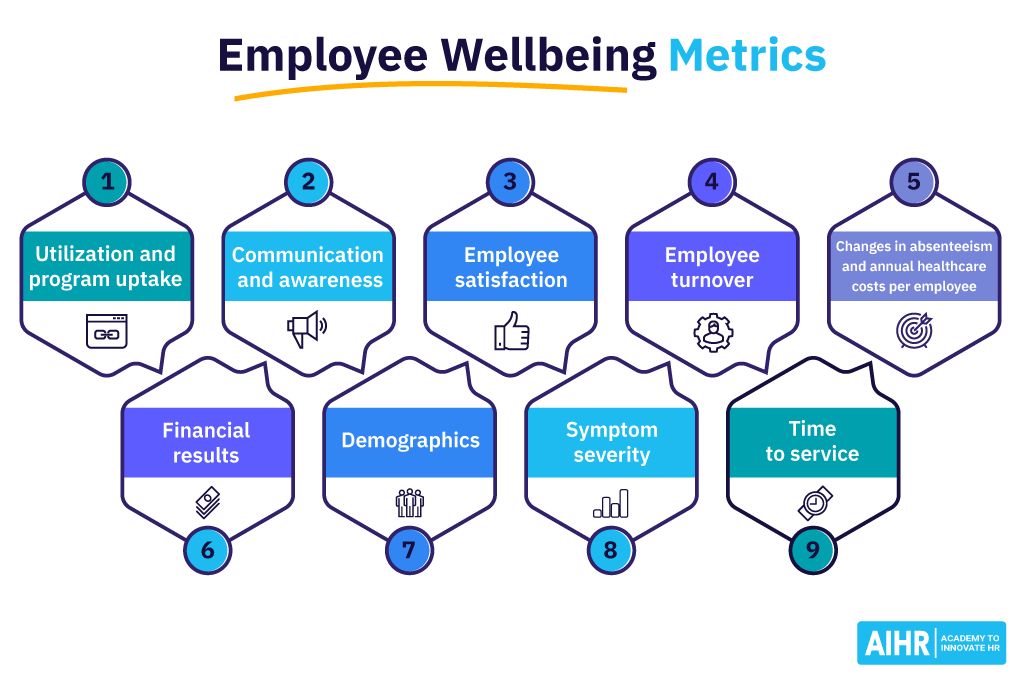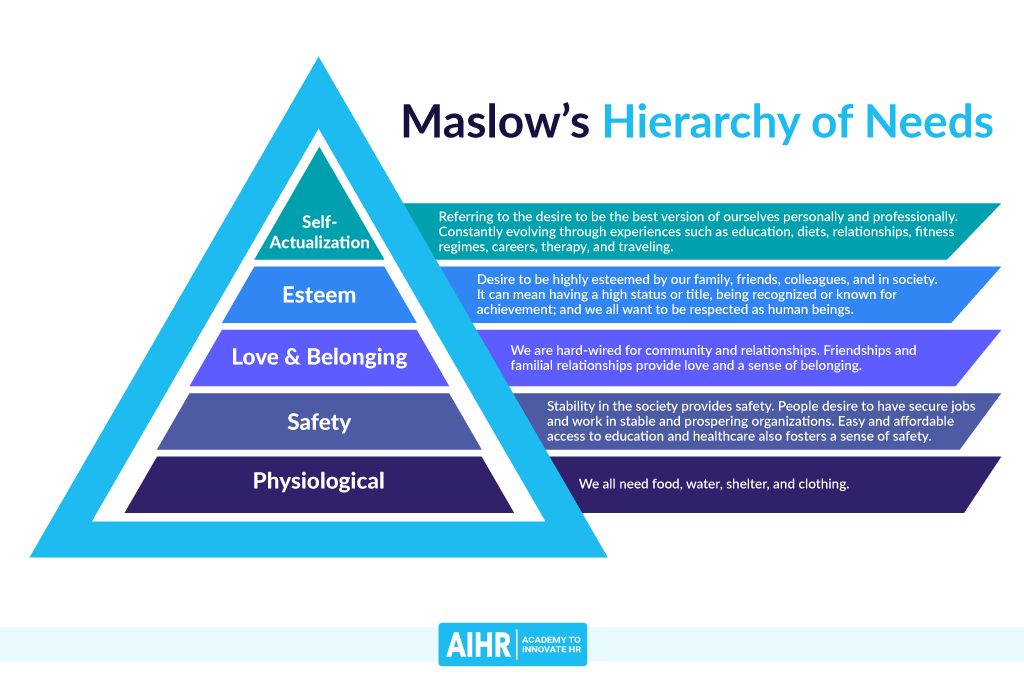9 Employee Wellbeing Metrics to Track Right Now

With people leaving organizations in droves and a tight labor market, there has never been a more urgent time to focus on employee wellbeing and engagement. How can employers make sure that their employee wellbeing efforts work? Let’s have a look at all you need to know about employee wellbeing metrics.
Contents
What are employee wellbeing metrics?
Why measure employee wellbeing?
Useful employee wellbeing metrics
What are employee wellbeing metrics?
Employee wellbeing metrics are data that help you assess the state of employee wellbeing at your organization and/or the success of an employee wellbeing program.
In the past, employee programs would focus on wellness, specifically on lifestyle management and physical fitness activities, like quitting smoking, regular exercise, and a healthy diet. Organizations would focus on these activities because they’re quantifiable and are known to reduce health care spending. We know that someone who doesn’t smoke is typically healthier than someone who does. Therefore, the smoker will spend more money on healthcare.
However, this approach misses other fundamental parts of wellbeing. Gallup, an American analytics and advisory company, determined that employee wellbeing comprises five elements:
- Career wellbeing: Liking what you do.
- Social wellbeing: Having meaningful friendships.
- Financial wellbeing: Managing money well.
- Physical wellbeing: You have enough energy.
- Community wellbeing: Loving where you live.
These elements inevitably translate to working life.
We already discussed that physical health could be tracked with basic numbers, but how you feel about your physical health can’t. Employees’ perceptions and attitudes to the quality of their work-life and financial wellbeing are also hard to measure but not impossible.
Proving the impact of wellbeing in the workplace is possible with employee wellbeing metrics.
Why measure employee wellbeing?
There are multiple reasons why you should track employee wellbeing. Here goes:
Engaging and retaining employees
Employee wellness and employee engagement are closely linked. People who report high levels of wellbeing are more engaged than people with poor wellbeing. In short, employee wellbeing is a key enabler of employee engagement and organizational performance.
We are in the midst of the Great Resignation, where employees are choosing to quit their jobs even without having anything else lined up. Simply said, they want the employers do better by them.
It’s still a widespread myth that employees are quitting because they don’t want to work. However, this isn’t compatible with the most recent Pew Research Center survey showing:
- 63% of employees quit because the pay was too low
- 63% of employees quit due to a lack of advancement opportunities
- 57% of employees quit because they felt disrespected at work
- 48% of employees quit because of childcare issues
- 45% of employees quit because of a lack of flexibility
- 43% of employees quit because of poor benefits
In other words, they lacked the employer taking care of different aspects of their wellbeing.
Companies who invest in communication strategies, fair compensation and benefits, and remote and flexible work are the ones who will be able to keep their staff. However, they won’t know what’s important to them without tracking the right metrics.
Employee retention metrics are also crucial in this area, and these metrics often intersect with wellbeing metrics. For example, employee satisfaction is a key indicator of whether or not an employee is going to stay with a company, and turnover costs could indicate poor wellness.
Wellbeing programs attract quality talent
Due to high competition, employers are trying to attract talent by offering various incentives.
For example, more employers are offering group life insurance, flexible hours, caregiver benefits, and better pay. In fact, that same Pew Research Center survey found that employees were paid more and received better benefits after they quit their job and were hired at another.
When you measure employee wellbeing, you’re able to see what matters the most to potential and current employees. This allows you to keep a finger on the job market pulse.
Healthy employees are less of a risk
The foundation of any good wellbeing program is the adoption of good habits and behaviors, which includes mental health. Combining mental and physical wellness is the best way to keep your employees healthy in long term, and help reduce your healthcare spending.
By tracking employee wellbeing metrics focused on your wellness and mental health programs, you can understand how you can increase the program usage.
Research shows that while 85% of large employers in the US offer a wellness program, only 24% of their employees participate in it, while 40% are not even aware their organization has such a program.
Improving productivity
Some of your employees are physically at work – whether on-site or remotely – but are they being productive?
When employees are at work but aren’t fully engaged with what they’re doing, they’re more likely to make mistakes, which wastes time and money. The phenomenon where employees go to work despite being sick, tired, or disengaged, is called presenteeism. It costs businesses 2 to 3 times more than direct health care expenses.
There are many reasons why employees have low productivity, but physical health and poor morale are typically the cause. A study on presenteeism found that 66% of people who don’t eat healthily and 55% who don’t exercise are more likely to have high presenteeism.
When you track employee wellbeing metrics, you can see why productivity is falling and immediately tackle the problem. Otherwise, you’ll start bleeding talents and your wallet.
Focus on wellbeing sustains morale and happiness
Maslow’s hierarchy of needs shows that when our needs are met, we start to focus on things that fuel the spirit. Our self-esteem, confidence, achievement, creativity, and problem-solving skills are at the top of the pyramid, so your employees have to be happy to act on higher needs.
When we’re depressed or unhappy, we aren’t keen on getting to work. You’ll need to offer your employees a wellbeing program fueled by metrics that address the root cause of unhappiness.
For example, a wellbeing program can decrease absenteeism. In a meta-analysis that compiled and studied over 46 papers, the analysts found that a comprehensive wellness program can:
- Improve good health behaviors, which lowers absenteeism
- Improve how employees control their stress, which decreases absenteeism
- Decrease blood pressure, glucose, and cholesterol, which reduces absenteeism
- Decrease rates of obesity and overweight, which lowers absenteeism.
Companies that reduce absenteeism will experience high cost savings.
A Harvard study found that medical costs fall by $3.27 for every dollar spent on wellness programs and absentee costs fall by $2.73 for every dollar spent.
How can you achieve these numbers? Make your employees happy! How do you make them happy? Track metrics and act on your findings!
Useful employee wellbeing metrics
Measuring employee wellbeing gives you the data you need to assess the success of your wellbeing initiative and overall state of wellbeing, identify negative trends, and change them quickly.
Bear in mind that you might be dealing with sensitive data related to employee health. That’s why you need to review relevant privacy regulations when collecting employee data, and make sure you’re handling the data in a compliant way.
Here are the key metrics you need in your company.
1. Utilization and program uptake
Utilization is the number of people who accessed your wellness program, while program uptake is a summary of program participation over a certain period. These metrics can help you see how the program is being adopted and what challenges prevent employee access.
You can typically collect the data from your wellness program platform.
2. Communication and awareness
As we’ve mentioned above, as many as 4 in 10 employees are unaware of their employer’s wellbeing and wellness programs. That’s why it’s important to track the frequency and open rates of your communications around your wellbeing initiatives.
Also, when conducting an employee engagement survey, you can ask how aware your employees are of your offering. Consider questions (rated on a scale from 1 to 5 or 10) like:
- My company provides clear information about the overall wellness offerings.
- My organization’s wellbeing initiatives suit my needs well.
You can also pose open-ended questions like:
- What types of employee wellbeing initiatives are the most appealing to you?
- What employee wellbeing initiatives have you taken advantage of in the last 6 months?
Measuring how well you communicate about your wellbeing programs and what employees think about them will help you create better strategies to showcase the value of the programs.
3. Employee satisfaction
The best way to know how someone is feeling is by asking them. Throughout your wellness program, send out anonymous surveys that rate stress levels, workloads, and happiness on a scale of 1-10. You can also ask them how satisfied they are with the services they’re getting through your wellbeing program.
This information enables you to better understand your employee’s needs.
4. Employee turnover
Organizations that apply wellbeing best practices have 11 percentage points lower turnover than organizations doing little in terms of employee wellbeing.
Tracking the changes in employee turnover helps you estimate the impact of your wellbeing initiatives. You can compare your employee turnover data with previous periods, or to industry benchmarks.
However, it might be difficult to isolate the effects of the wellbeing initiatives when looking at your turnover data. Combine the data with the information from your exit interviews and exit surveys to learn more about the reasons why people leave your organization.
5. Changes in absenteeism and annual healthcare costs per employee
Examine the total amount of absenteeism and healthcare costs before and after implementing a new wellbeing initiative. For example, if you adopt mental health software for your workplace mental health program, track the changes in absenteeism rate and healthcare costs to assess its impact over time.
While adding more initiatives adds to your costs, 78% of employees miss work or go on leave due to mental health.
6. Financial results
If you want to assess how investing into a wellbeing program impacts your organization financially, you should look into how much savings the improvements in employee wellbeing translate to.
As we’ve already mentioned, you can see how much you’re saving on disability insurance costs.
What you can also do is estimate the cost of absenteeism at your organization and then calculate what savings the reduction in absenteeism results in. Sparck suggest the following formula:
(Average Revenue Per Employee x Average Sick Days) + (Average Salary x Average Sick Days) = Absenteeism cost
7. Demographics
The demographics metric summarizes active program participants based on gender, age, sexual orientation, and more. This helps you understand if certain groups face barriers in getting the help they need. For example, some people might not make use of a mental health program because they have a language barrier and there’s a lack of mental healthcare providers who speak their language.
Also, different demographic groups might have different needs. Diving deeper into the data enables you to address this.
You can work on removing the barriers and create inclusive wellbeing initiatives.
8. Symptom severity
Take the currency status of your employees based on medical records (consensually provided) and surveys and compare them quarterly.
Let’s say that you want to understand how your new mental health offering is helping your employees deal with stress, which you’ve previously identified as an issue. Emotional symptoms of stress include moodiness, being unable to switch off, and feelings of frustration, agitation, and being overwhelmed.
You can conduct an anonymous survey where your employees self-report the symptom severity and track how it changes as employees make use of the offering.
9. Time to service
This metric tracks how much time it takes from the moment an employee requests help within your wellbeing program to when they receive the services they need. Time to service is especially relevant for mental health services.
Tracking this metric doesn’t only help you look for ways to keep your wait times reasonable, but it also allows you to manage employee expectations about how long it takes to receive the required help.
Final thoughts
Employee wellbeing metrics rely on surveys, active listening, and empathy. It’s often difficult, or even impossible, to stay on top of employee wellbeing with raw numbers alone; you need to actively speak to your employees to understand what they need. Employee wellbeing depends on it.
While initiating a wellbeing program will take a lot of money and effort, it’s worth it in the end. Once your program gets off the ground, you’ll experience higher satisfaction rates, but also cost savings.
Remember: When you invest in your employees, you’re investing in your company’s future.
Weekly update
Stay up-to-date with the latest news, trends, and resources in HR
Learn more
Related articles
Are you ready for the future of HR?
Learn modern and relevant HR skills, online














